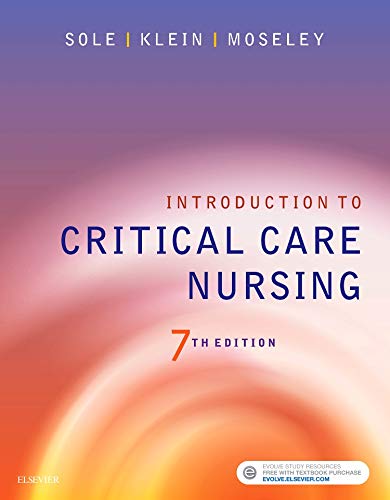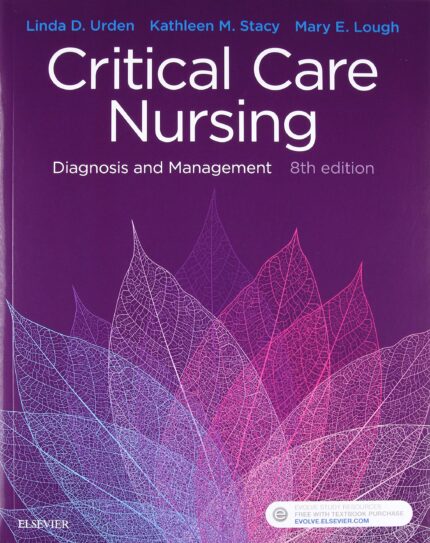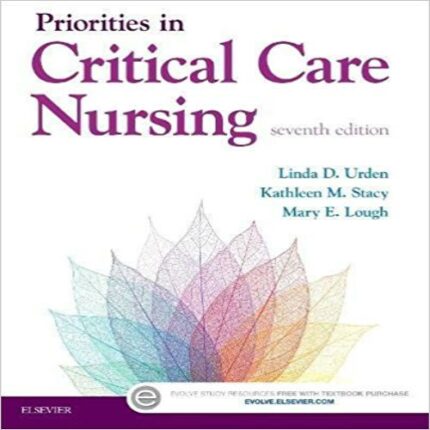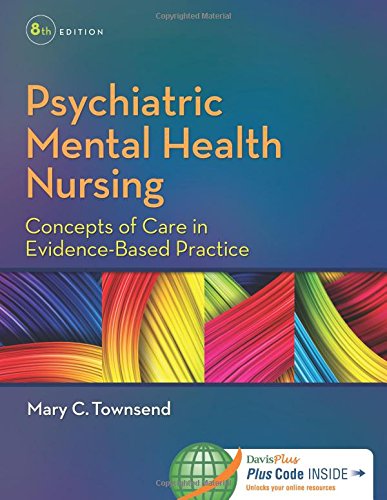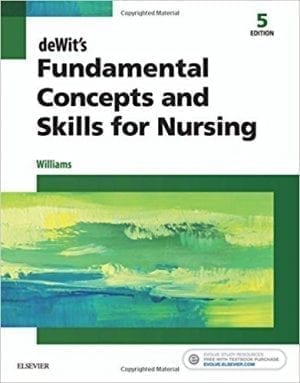Test Bank for Introduction to Critical Care Nursing 7th Edition by Sole
Chapter 05: Comfort and Sedation
Sole: Introduction to Critical Care Nursing, 7th Edition
MULTIPLE CHOICE
1.Nociceptors differ from other nerve receptors in the body in that they:
| a. | adapt very little to continual pain response. |
| b. | inhibit the infiltration of neutrophils and eosinophils. |
| c. | play no role in the inflammatory response. |
| d. | transmit only the thermal stimuli. |
ANS: A
Nociceptors are stimulated by mechanical, chemical, or thermal stimuli. Nociceptors differ from other nerve receptors in the body in that they adapt very little to the pain response. The body continues to experience pain until the stimulus is discontinued or therapy is initiated. This is a protective mechanism so that the body tissues being damaged will be removed from harm. Nociceptors usually initiate inflammatory responses near injured capillaries. As such, the response promotes infiltration of injured tissues with neutrophils and eosinophils.
DIF: Cognitive Level: Remember/Knowledge REF: p. 54
OBJ:Discuss the physiology of pain and anxiety.
TOP:Nursing Process Step: Assessment
MSC: NCLEX Client Needs Category: Physiological Integrity
2.A postsurgical patient is on a ventilator in the critical care unit. The patient has been tolerating the ventilator well and has not required any sedation. On assessment, the nurse notes the patient is tachycardic and hypertensive with an increased respiratory rate of 28 breaths/min. The patient has been suctioned recently via the endotracheal tube, and the airway is clear. The patient responds appropriately to the nurse’s commands. The nurse should:
| a. | assess the patient’s level of pain. |
| b. | decrease the ventilator rate. |
| c. | provide sedation as ordered. |
| d. | suction the patient again. |
ANS: A
Pulse, respirations, and blood pressure frequently result from activation of the sympathetic nervous system by the pain stimulus. Because the patient is postoperative, the patient should be assessed for the presence of pain and need for pain medication. Decreasing the ventilator rate will not help in this situation. Providing sedation may calm the patient but will not solve the problem if the physiological changes are from pain. The patient has just been suctioned and the airway is clear. There is no need to suction again.
DIF: Cognitive Level: Analyze/Analysis REF: p. 55
OBJ: Describe the positive and negative effects of pain and anxiety in critically ill patients.
TOP:Nursing Process Step: Assessment
MSC: NCLEX Client Needs Category: Physiological Integrity
3.The assessment of pain and anxiety is a continuous process. When critically ill patients exhibit signs of anxiety, the nurse’s first priority is to
| a. | administer antianxiety medications as ordered. |
| b. | administer pain medication as ordered. |
| c. | identify and treat the underlying cause. |
| d. | reassess the patient hourly to determine whether symptoms resolve on their own. |
ANS: C
When patients exhibit signs of anxiety or agitation, the first priority is to identify and treat the underlying cause, which could be hypoxemia, hypoglycemia, hypotension, pain, or withdrawal from alcohol and drugs. Treatment is not initiated until assessment is completed. Medication may not be needed if the underlying cause can be resolved.
DIF: Cognitive Level: Apply/Application REF: p. 70 | Table 5-11
OBJ: Describe methods and tools for assessing pain and anxiety in the critically ill patient.
TOP:Nursing Process Step: Assessment
MSC: NCLEX Client Needs Category: Physiological Integrity
4.Both the electroencephalogram (EEG) monitor and the Bispectral Index Score (BIS) or Patient State Index (PSI) analyzer monitors are used to assess patient sedation levels in critically ill patients. The BIS and PSI monitors are simpler to use because they
| a. | can be used only on heavily sedated patients. |
| b. | can be used only on pediatric patients. |
| c. | provide raw EEG data and a numeric value. |
| d. | require only five leads. |
ANS: C
The BIS and PSI have very simple steps for application, and results are displayed as raw EEG data and the numeric value. A single electrode is placed across the patient’s forehead and is attached to a monitor. These monitors can be used in both children and adults and in patients with varying levels of sedation.
DIF: Cognitive Level: Understand/Comprehension REF: p. 60
OBJ: Describe methods and tools for assessing pain and anxiety in the critically ill patient.
TOP:Nursing Process Step: Assessment
MSC: NCLEX Client Needs Category: Physiological Integrity
5.The nurse is caring for a patient who requires administration of a neuromuscular blocking agent to facilitate ventilation with nontraditional modes. The nurse understands that neuromuscular blocking agents provide:
| a. | antianxiety effects. |
| b. | complete analgesia. |
| c. | high levels of sedation. |
| d. | no sedation or analgesia. |
ANS: D
Neuromuscular blocking (NMB) agents do not possess any sedative or analgesic properties. Patients who receive NMBs must also receive sedatives and pain medication.
DIF: Cognitive Level: Remember/Knowledge REF: p. 72
OBJ: Discuss assessment and management challenges in subsets of critically ill patients.
TOP:Nursing Process Step: Implementation
MSC: NCLEX Client Needs Category: Physiological Integrity
6.The patient is receiving neuromuscular blockade. Which nursing assessment indicates a target level of paralysis?
| a. | Glasgow Coma Scale score of 3 |
| b. | Train-of-four yields two twitches |
| c. | Bispectral index of 60 |
| d. | CAM-ICU positive |
ANS: B
A train-of-four response of two twitches (out of four) using a peripheral nerve stimulator indicates adequate paralysis. The Glasgow Coma Scale does not assess paralysis; it is an indicator of consciousness. The bispectral index provides an assessment of sedation. The CAM-ICU is a tool to assess delirium.
DIF: Cognitive Level: Remember/Knowledge REF: p. 73
OBJ: Discuss assessment and management challenges in subsets of critically ill patients.
TOP:Nursing Process Step: Assessment
MSC: NCLEX Client Needs Category: Physiological Integrity
7.The nurse is concerned that the patient will pull out the endotracheal tube. As part of the nursing management, the nurse obtains an order for
| a. | arm binders or splints. |
| b. | a higher dosage of lorazepam. |
| c. | propofol. |
| d. | soft wrist restraints. |
ANS: D
The priority in caring for agitated patients is safety. The least restrictive methods of keeping the patient safe are appropriate. If possible, the tube or device causing irritation should be removed, but if that is not possible, the nurse must prevent the patient from pulling it out. Restraints are associated with an increased incidence of agitation and delirium. Therefore, restraints should not be used unless as a last resort for combative patients. The least amount of sedation is also recommended; therefore, neither increasing the dosage of lorazepam nor adding propofol is indicated and would be likely to prolong mechanical ventilation.
DIF: Cognitive Level: Apply/Application REF: p. 61
OBJ:Identify nonpharmacological and pharmacological strategies to promote comfort and reduce anxiety.TOP:Nursing Process Step: Planning
MSC: NCLEX Client Needs Category: Safe and Effective Care Environment
8.The primary mode of action for neuromuscular blocking agents used in the management of some ventilated patients is
| a. | analgesia. |
| b. | anticonvulsant therapy. |
| c. | paralysis. |
| d. | sedation. |
ANS: C
These agents cause respiratory muscle paralysis. They do not provide analgesia or sedation. They do not have anticonvulsant properties.
DIF: Cognitive Level: Remember/Knowledge REF: p. 72
OBJ: Discuss assessment and management challenges in subsets of critically ill patients.
TOP:Nursing Process Step: Implementation
MSC: NCLEX Client Needs Category: Physiological Integrity
9.The most important nursing intervention for patients who receive neuromuscular blocking agents is to
| a. | administer sedatives in conjunction with the neuromuscular blocking agents. |
| b. | assess neurological status every 30 minutes. |
| c. | avoid interaction with the patient, because he or she won’t be able to hear. |
| d. | restrain the patient to avoid self-extubation. |
ANS: A
Neuromuscular blocking agents cause paralysis only; they do not cause sedation. Therefore, concomitant administration of sedatives is essential. Neurological status is monitored according to unit protocol. Nurses should communicate with all critically ill patients, regardless of their status. If the patient is paralyzed, restraining devices may not be needed.
DIF: Cognitive Level: Apply/Application REF: p. 72
OBJ: Discuss assessment and management challenges in subsets of critically ill patients.
TOP:Nursing Process Step: Implementation
MSC: NCLEX Client Needs Category: Physiological Integrity
10.The best way to monitor agitation and effectiveness of treating it in the critically ill patient is to use a/the:
| a. | Confusion Assessment Method (CAM-ICU). |
| b. | FACES assessment tool. |
| c. | Glasgow Coma Scale. |
| d. | Richmond Agitation Sedation Scale. |
ANS: D
Various sedation scales are available to assist the nurse in monitoring the level of sedation and assessing response to treatment. The Richmond Agitation Sedation Scale is a commonly used tool that has been validated. The CAM-ICU assesses for delirium. The FACES scale assesses pain. The Glasgow Coma Scale assesses neurological status.
DIF: Cognitive Level: Remember/Knowledge REF: p. 59 | Table 5-5
OBJ: Describe methods and tools for assessing pain and anxiety in the critically ill patient.
TOP:Nursing Process Step: Assessment
MSC: NCLEX Client Needs Category: Physiological Integrity
11.The nurse is caring for a patient receiving intravenous ibuprofen for pain management. The nurse recognizes which laboratory assessment to be a possible side effect of the ibuprofen?
| a. | Creatinine: 3.1 mg/dL |
| b. | Platelet count 350,000 billion/L |
| c. | White blood count 13, 550 mm3 |
| d. | ALT 25 U/L |
ANS: A
Ibuprofen can result in renal insufficiency, which may be noted in an elevated serum creatinine level. Thrombocytopenia (low platelet count) is another possible side effect. This platelet count is elevated. An elevated white blood count indicates infection. Although ibuprofen is cleared primarily by the kidneys, it is also important to assess liver function, which would show elevated liver enzymes, not low values such as shown here.
DIF: Cognitive Level: Analyze/Analysis REF: p. 71
OBJ:Identify nonpharmacological and pharmacological strategies to promote comfort and reduce anxiety.TOP:Nursing Process Step: Evaluation
MSC: NCLEX Client Needs Category: Physiological Integrity
12.The nurse is assessing pain levels in a critically ill patient using the Behavioral Pain Scale. The nurse recognizes __________ as indicating the greatest level of pain.
| a. | brow lowering |
| b. | eyelid closing |
| c. | grimacing |
| d. | relaxed facial expression |
ANS: C
The Behavioral Pain Scale issues the most points, indicating the greatest amount of pain, to assessment of facial grimacing.
DIF: Cognitive Level: Understand/Comprehension REF: p. 58 | Table 5-3
OBJ: Describe methods and tools for assessing pain and anxiety in the critically ill patient.
TOP:Nursing Process Step: Assessment
MSC: NCLEX Client Needs Category: Physiological Integrity
13.The nurse wishes to assess the quality of a patient’s pain. Which of the following questions is appropriate to obtain this assessment if the patient is able to give a verbal response?
| a. | “Is the pain constant or intermittent?” |
| b. | “Is the pain sharp, dull, or crushing?” |
| c. | “What makes the pain better? Worse?” |
| d. | “When did the pain start?” |
ANS: B
If the patient can describe the pain, the nurse can assess quality, such as sharp, dull, or crushing. The other responses relate to continuous or intermittent presence, what provides relief, and duration.
DIF: Cognitive Level: Understand/Comprehension REF: p. 56
OBJ: Describe methods and tools for assessing pain and anxiety in the critically ill patient.
TOP:Nursing Process Step: Assessment
MSC: NCLEX Client Needs Category: Physiological Integrity
14.The nurse is assessing the patient’s pain using the Critical Care Pain Observation Tool. Which of the following assessments would indicate the greatest likelihood of pain and need for nursing intervention?
| a. | Absence of vocal sounds |
| b. | Fighting the ventilator |
| c. | Moving legs in bed |
| d. | Relaxed muscles in upper extremities |
ANS: B
Fighting the ventilator is rated with the greatest number of points for compliance with the ventilator, and could indicate pain or anxiety. Absence of vocal sounds (e.g., no crying) and relaxed muscles do not indicate pain and are not given a point value. The patient may be moving the legs as a method of range of motion, not necessarily in response to pain. The patient needs to be assessed for restlessness if the movement is excessive.
DIF: Cognitive Level: Apply/Application REF: p. 59 | Table 5-4
OBJ: Describe methods and tools for assessing pain and anxiety in the critically ill patient.
TOP:Nursing Process Step: Assessment
MSC: NCLEX Client Needs Category: Physiological Integrity
15.The nurse is caring for four patients on the progressive care unit. Which patient is at greatest risk for developing delirium?
| a. | 36-year-old recovering from a motor vehicle crash; being treated with an evidence-based alcohol withdrawal protocol. |
| b. | 54-year-old postoperative aortic aneurysm resection with a 40 pack-year history of smoking |
| c. | 86-year-old from nursing home with dementia, postoperative from colon resection, still being mechanically ventilated |
| d. | 95-year-old with community-acquired pneumonia; family has brought in eyeglasses and hearing aid |
ANS: C
From this list, the 86-year-old postoperative nursing home resident is at greatest risk due to advanced age, cognitive impairment, and some degree of respiratory failure. The 96-year-old has been provided eyeglasses and a hearing aid, which will decrease the risk of delirium. Smoking is a possible risk for delirium. The 36-year-old is receiving medications as part of an alcohol withdrawal protocol, which should decrease the risk for delirium.
DIF: Cognitive Level: Analyze/Analysis REF: p. 61 | Table 5-8
OBJ: Describe methods and tools for assessing pain and anxiety in the critically ill patient.
TOP:Nursing Process Step: Assessment
MSC: NCLEX Client Needs Category: Physiological Integrity
16.The nurse is caring for a patient with hyperactive delirium. The nurse focuses interventions toward keeping the patient:
| a. | comfortable. |
| b. | nourished. |
| c. | safe. |
| d. | sedated. |
ANS: C
The greatest priority in managing delirium is to keep the patient safe. Sedation may contribute to the development of delirium. Comfort and nutrition are important, but they are not priorities.
DIF: Cognitive Level: Understand/Comprehension REF: p. 61
OBJ: Identify nonpharmacological and pharmacological strategies to promote comfort, reduce anxiety, and prevent delirium. TOP: Nursing Process Step: Implementation
MSC: NCLEX Client Needs Category: Safe and Effective Care Environment
17.The nurse is caring for a critically ill trauma patient who is expected to be hospitalized for an extended period. Which of the following nursing interventions would improve the patient’s well-being and reduce anxiety the most?
| a. | Arrange for the patient’s dog to be brought into the unit (per protocol). |
| b. | Provide aromatherapy with scents such as lavender that are known to help anxiety. |
| c. | Secure the harpist to come and play soothing music for an hour every afternoon. |
| d. | Wheel the patient out near the unit aquarium to observe the tropical fish. |
ANS: A
Nonpharmacological approaches are helpful in reducing stress and anxiety, and each of these activities has the potential for improving the patient’s well-being. The patient is likely to benefit most from the presence of his or her own dog rather than the other activities, however; if unit protocol does not allow the patient’s own dog, the nurse should investigate the use of therapy animals or the other options.
DIF: Cognitive Level: Apply/Application REF: p. 64
OBJ: Identify nonpharmacological and pharmacological strategies to promote comfort, reduce anxiety, and prevent delirium. TOP: Nursing Process Step: Intervention
MSC: NCLEX Client Needs Category: Psychological Integrity
18.The nurse recognizes that which patient is likely to benefit most from patient-controlled analgesia (PCA)?
| a. | Patient with a C4 fracture and quadriplegia |
| b. | Patient with a femur fracture and closed head injury |
| c. | Postoperative patient who had elective bariatric surgery |
| d. | Postoperative cardiac surgery patient with mild dementia |
ANS: C
The patient undergoing bariatric surgery (an elective procedure) is the best candidate for PCA as this patient should be awake, cognitively intact, and will have the acute pain related to the surgical procedure. The quadriplegic would be unable to operate the PCA pump. The cardiac surgery patient with mild dementia may not understand how to operate the pump. Likewise, the patient with the closed head injury may not be cognitively intact.
DIF: Cognitive Level: Analyze/Analysis REF: p. 71 | Box 5-6
OBJ: Identify nonpharmacological and pharmacological strategies to promote comfort, reduce anxiety, and prevent delirium. TOP: Nursing Process Step: Intervention
MSC: NCLEX Client Needs Category: Physiological Integrity
19.The nurse is caring for a patient receiving a benzodiazepine intermittently. The nurse understands that the best way to administer such drugs is to:
| a. | administer around the clock, rather than as needed, to ensure constant sedation. |
| b. | administer the medications through the feeding tube to prevent complications. |
| c. | give the highest allowable dose for the greatest effect. |
| d. | titrate to a predefined endpoint using a standard sedation scale. |
ANS: D
The best approach for administering benzodiazepines (and all sedatives) is to administer and titrate to a desired endpoint using a standard sedation scale. Administering around the clock as well as giving the highest allowable dose without basing it on an assessment target may result in excessive sedation. For greatest effect, most benzodiazepines are given intravenously.
DIF: Cognitive Level: Apply/Application REF: p. 72
OBJ: Identify nonpharmacological and pharmacological strategies to promote comfort, reduce anxiety, and prevent delirium. TOP: Nursing Process Step: Intervention
MSC: NCLEX Client Needs Category: Physiological Integrity
20.The nurse is concerned about the risk of alcohol withdrawal syndrome in a postoperative patient. Which statement by the nurse indicates understanding of management of this patient?
| a. | “Alcohol withdrawal is common; we see it all of the time in the trauma unit.” |
| b. | “There is no way to assess for alcohol withdrawal.” |
| c. | “This patient will require less pain medication.” |
| d. | “We have initiated the alcohol withdrawal protocol.” |
ANS: D
The most important treatment of alcohol withdrawal syndrome is prevention. Many units have protocols that are initiated early to prevent the syndrome. Alcohol withdrawal syndrome is common; however, this statement does not indicate knowledge of management. The patient experiencing alcohol withdrawal may exhibit a variety of symptoms, such as disorientation, agitation, and tachycardia. Patients with substance abuse require increased dosages of pain medications.
DIF: Cognitive Level: Understand/Comprehension REF: p. 74
OBJ: Identify nonpharmacological and pharmacological strategies to promote comfort, reduce anxiety, and prevent delirium. TOP: Nursing Process Step: Intervention
MSC: NCLEX Client Needs Category: Physiological Integrity
MULTIPLE RESPONSE
1.Nonpharmacological approaches to pain and/or anxiety that may best meet the needs of critically ill patients include: (Select all that apply.)
| a. | anaerobic exercise. |
| b. | art therapy. |
| c. | guided imagery. |
| d. | music therapy. |
| e. | animal therapy. |
ANS: C, D, E
Guided imagery is a powerful technique for controlling pain and anxiety, especially that associated with painful procedures. Similar to guided imagery, a music therapy program offers patients a diversionary technique for pain and anxiety relief. Likewise animal therapy has many benefits for the critically ill patient. Anaerobic exercise is not a nonpharmacological approach for managing pain and anxiety. Most critically ill patients are not able to participate in art therapy.
DIF: Cognitive Level: Remember/Knowledge REF: pp. 62-64
OBJ:Identify nonpharmacological and pharmacological strategies to promote comfort and reduce anxiety.TOP:Nursing Process Step: Implementation
MSC: NCLEX Client Needs Category: Physiological Integrity
2.Which of the following statements regarding pain and anxiety are true? (Select all that apply.)
| a. | Anxiety is a state marked by apprehension, agitation, autonomic arousal, and/or fearful withdrawal. |
| b. | Critically ill patients often experience anxiety, but they rarely experience pain. |
| c. | Pain and anxiety are often interrelated and may be difficult to differentiate because their physiological and behavioral manifestations are similar. |
| d. | Pain is defined by each patient; it is whatever the person experiencing the pain says it is. |
| e. | While anxiety is unpleasant, it does not contribute to mortality or morbidity of the critically ill patient. |
ANS: A, C, D
Pain is defined by each patient, anxiety is associated with marked apprehension, and pain and anxiety are often interrelated. Critically ill patients commonly have both pain and anxiety. Anxiety does increase both morbidity and mortality in critically ill patients, especially those with cardiovascular disease.
DIF: Cognitive Level: Understand/Comprehension REF: p. 53
OBJ: Define pain and anxiety. TOP: Nursing Process Step: Planning
MSC: NCLEX Client Needs Category: Physiological Integrity
3.Which of the following factors predispose the critically ill patient to pain and anxiety? (Select all that apply.)
| a. | Inability to communicate |
| b. | Invasive procedures |
| c. | Monitoring devices |
| d. | Nursing care |
| e. | Preexisting conditions |
ANS: A, B, C, D, E
All of these factors predispose the patient to pain or anxiety.
DIF: Cognitive Level: Remember/Knowledge REF: pp. 53-54
OBJ: Identify factors that place the critically ill patient at risk for developing pain and anxiety.
TOP:Nursing Process Step: Assessment
MSC: NCLEX Client Needs Category: Physiological Integrity
4.Choose the items that are common to both pain and anxiety. (Select all that apply.)
| a. | Cyclical exacerbation of one another |
| b. | Require good nursing assessment for proper treatment |
| c. | Response only to real phenomena |
| d. | Subjective in nature |
| e. | Perception may be influenced by prior experience |
ANS: A, B, D, E
Both pain and anxiety are subjective in nature. One can exacerbate the other in a vicious cycle that often requires good nursing assessment to manage the precipitating problem and break the cycle. Anxiety is a response to a real or perceived fear. Pain is a response to real or “phantom” phenomenon but always involves transmission of nerve impulses. Both relate to the patient’s perceptions of pain and fear. Previous experiences of both pain and/or anxiety can influence the patient’s perception of both. Anxiety is a response to real or perceived fear, and pain is a response to a real or “phantom” phenomenon.
DIF: Cognitive Level: Understand/Comprehension REF: pp. 53-54
OBJ: Identify factors that place the critically ill patient at risk for developing pain and anxiety.
TOP:Nursing Process Step: Assessment
MSC: NCLEX Client Needs Category: Physiological Integrity
5.Anxiety differs from pain in that: (Select all that apply.)
| a. | it is confined to neurological processes in the brain. |
| b. | it is linked to reward and punishment centers in the limbic system. |
| c. | it is subjective. |
| d. | there is no actual tissue injury. |
| e. | it can be increased by noise and light. |
ANS: A, B, D, E
Unlike pain, anxiety is linked to the reward and punishment centers in the limbic system of the brain. It is totally neurological and does not involve tissue injury. Like pain, it is a subjective phenomenon. Noise, light, and other stimuli can increase the intensity of anxiety. Both anxiety and pain are subjective in nature.
DIF: Cognitive Level: Understand/Comprehension REF: pp. 53-55
OBJ:Discuss the physiology of pain and anxiety.
TOP: Nursing Process Step: Assessment
6.Factors in the critical care unit that may predispose the client to increased pain and anxiety include: (Select all that apply.)
| a. | an endotracheal tube. |
| b. | frequent vital signs. |
| c. | monitor alarms. |
| d. | room temperature. |
| e. | hostile environment. |
ANS: A, B, C, D, E
Anxiety is likely to result from loss of control, the inability to communicate, continuous noise and lighting, excessive stimulation (including repeated vital sign measurements), lack of mobility, and uncomfortable room temperatures. Increased anxiety levels often lead to increased pain perception. Environments that are perceived as hostile also contribute.
DIF: Cognitive Level: Understand/Comprehension REF: pp. 53-54
OBJ: Identify factors that place the critically ill patient at risk for developing pain and anxiety.
TOP:Nursing Process Step: Assessment
MSC: NCLEX Client Needs Category: Physiological Integrity
7.In the healthy individual, pain and anxiety: (Select all that apply.)
| a. | activate the sympathetic nervous system (SNS). |
| b. | decrease stress levels. |
| c. | help remove one from harm. |
| d. | increase performance levels. |
| e. | limit sympathetic nervous system activity. |
ANS: A, C, D
In the healthy person, pain and anxiety are adaptive mechanisms used to increase performance levels or to remove one from potential harm. The “fight or flight” response occurs in response to pain and/or anxiety and involves the activation of the sympathetic nervous system. Pain and anxiety, however, can induce significant stress. The SNS is activated, not limited, by pain and/or anxiety.
DIF: Cognitive Level: Remember/Knowledge REF: p. 55
OBJ: Describe the positive and negative effects of pain and anxiety in critically ill patients.
TOP:Nursing Process Step: Assessment
MSC: NCLEX Client Needs Category: Physiological Integrity
8.The nurse is caring for a patient who is intubated and on a ventilator following extensive abdominal surgery. Although the patient is responsive, the nurse is not able to read the patient’s lips as the patient attempts to mouth the words. Which of the following assessment tools would be the most appropriate for the nurse to use when assessing the patient’s pain level? (Select all that apply.)
| a. | The FACES scale |
| b. | Pain Intensity Scale |
| c. | The PQRST method |
| d. | The Visual Analogue Scale |
| e. | The CAM tool |
ANS: A, D

